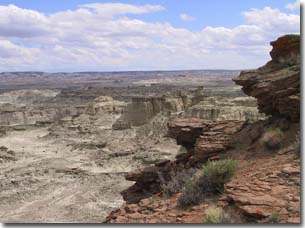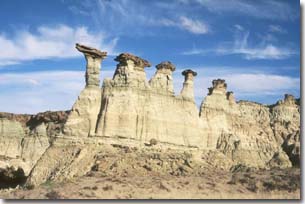

ADOBE TOWN
ADOBE TOWN
Information
Elk wander the rims surrounding this sandstone labyrinth of twisting arroyos and towering hoodoos, which hides wild horses, fossilized crocodiles and mummified human remains.
Built by nature’s most accomplished engineers— water and wind— Wyoming’s Adobe Town has been under construction for more than 40 million years. Today, the pair continue to chisel and smooth, etch and polish, constantly reshaping a maze of pastel-painted sandstone formations—some rising a thousand feet into the air—resembling stalagmites, pueblos, haystacks, cathedral spires, the Sphinx and whatever else the imagination conjures up.Adobe Town occupies one
corner of the larger Adobe Town Wilderness Study Area, more than 85,000 acres of
public land located in the southern reaches of the Red Desert and managed by the
Bureau of Land Management (BLM). Classified as cold desert, the region lies at
an elevation of 7,000 feet and receives less than six inches of precipitation a
year. Temperatures soar into the high 90s during the summer months and can dip
to 30 degrees below zero in winter.
Nearly waterless now, this
land was once covered by brackish marsh. During the Eocene Epoch between 60 and
38 million years ago, crocodiles, woolly rhinoceroses, giant turtles, ground
sloths and other strange creatures roamed the region. Over time, as the Rocky
Mountains rose to the west and wrung out the rain clouds from the Pacific Ocean,
the land dried out. Since the late 1800s, paleontologists have uncovered fossils
from prehistoric animals, as well as remains of the first people to live in the
Red Desert. Mummified human remains have been discovered in burial sites and
rock shelters dating back 12,000 years.
Today, Adobe Town and the
Red Desert teem with creatures who have adapted to this high, cold country. Wild
horses, antelope, mule deer, coyotes, prairie dogs, pygmy rabbits, kangaroo
rats, sage grouse, ferruginous hawks, burrowing owls, rattlesnakes, short-horned
lizards and many others enliven the badlands and surrounding sagebrush range and
juniper woodlands. The Red Desert is home to one of the few desert elk herds
left in the United States. These elk use hills, valleys and sand dunes for
cover, feed on grasses, sage and saltbush and calve in the desert’s big
sagebrush stands.
The partners teamed again in 2004 to develop an enclosed spring and water troughs at Bull Springs northwest of Rawlins. The effort also constructed 4.5 miles of pasture fence in the area to limit use by wild horses and cattle, while providing a ready water source for elk, antelope and other wildlife.
Standing on the edge of the Skull Creek Rim in the heart of Adobe Town, the wind at your back, it is hard to imagine that the panorama of thousand-foot walls whittled by wind, sand, and time is not already part of a national park. From, here, the eye can travel up and down 25 miles of ramparts, pillars, and ravines. From here, it is an easy proposition to hike down along the tops of the cliffs, where the steep badlands drop away into space above the arid plain of Skull Creek. Knobs and buttes topped by a reddish cap rock provide perches and aeries for hawks and eagles, which find safety from land-based predators atop the inaccessible pinnacles. Erosion has worn natural arches and sinkholes into the soft bedrock, which is made of volcanic ash brought down from the Yellowstone Plateau by ancient rivers, and deposited in a long-vanished lakebed.
Hidden in the eroded stone are the fossils of ancient mammals, such as woolly rhinoceroses and giant ground sloths that stood eight feet tall at the shoulder. Thousands of years ago, grassy savannas covered these lands during a period of more moderate climate, and a rich fauna that included primitive horses, camels, and antelopes roamed this land. Adobe Town has become one of the nation's most important dig sites for paleontologists studying these long-extinct animals. Much later, the lakeshore environments found here were frequented by bands of early prehistoric peoples, who left a rich records of their passing in the form of campsites and tool-making stations are only beginning to be studied by archaeologists.
 Adobe Town Rim Biodiversity Conservation Alliance |
East Fork Point is a great promontory that anchors the center of this line of cliffs. Traveling south from this point, the ramparts dissolve into a series of isolated buttes that are scattered like an archipelago across a sea of sand.
To the west is a high peneplain, where small dunes robed in sagebrush huddle around flat pans sparsely covered in hardy desert grasses. Herds of wild horses hide among the vegetated dunes and gallop across the flats, tiny puffs of dust rising from every strike of their hooves. Often the horses are shadowed by an antelope or two, racing silently like pale ghosts across the desert. The Adobe Town herd is the largest herd of wild horses in Wyoming, numbering over 1,300 animals. Visitors to Adobe Town can expect to see half a dozen herds each day roaming free across the desert.
The Powder Rim rises along the south edge of the proposed wilderness, a rounded swell of high ground robed in woodlands of gnarled and ancient juniper. Here, birdwatchers can find rare Wyoming residents such as the Scott's oriole, Bewick's wren, and the juniper titmouse. Mule deer are abundant in these hills, and a desert elk herd known as the Petition Herd haunts its woodlands year-round. The Powder Rim provides crucial winter habitat for many types of big game animals, and is an important migration corridor as well, receiving elk from as far away as the Sierra Madre and Elkhead Mountains. The western end of the Powder Rim is a howling wilderness, but was originally excluded from the Adobe Town Wilderness Study Area by the Bureau of Land Management. Thus, it is currently unprotected. But the BLM has since re-inventoried the area and recognized its wilderness qualities, and may soon offer some protection for this wild corner of Adobe Town.
How to get to Adobe Town
From Interstate 80 drive west from Rawlins to Exit 142, the Bitter Creek exit. Take the Bitter Creek exit and drive south on Bitter Creek Road (County 19). After crossing the railroad tracks at approximately mile 7, stay on County 19 and follow the signs for the Eversole Ranch.
The ranch is about 27 miles from I-80 exit. Drive through the ranch, taking the left fork in the road, and go 1.8 miles. The road forks again here, so go straight ahead on an unmarked BLM road; do NOT take County 19 which turns to the right (SW). Follow the unmarked road for 3.4 miles. Turn left onto a gravel road going east to the Adobe Town Rim. The Rim is about 2.5 miles after you turn onto the gravel road.
Adobe Town Conservation
This spring, the Rawlins BLM is revising its Great Divide Resource Management Plan, a long-term blueprint for the management of 3.5 million acres of public land, including most of Adobe Town. To help, write a letter asking the BLM to withdraw the unprotected parts of Adobe Town from industrial use, and send it to:
|
Dave Simons |
Rawlins Field Office, BLM | 1300 N. 3rd St. |
Rawlins, WY 82301 |
|
Visitors Guide - Wyoming Travel Information
The Carbon County Visitors Counsel is located in Riverside, Wyoming off HWY 70. Click on the picture for more information on things to do in Carbon County.